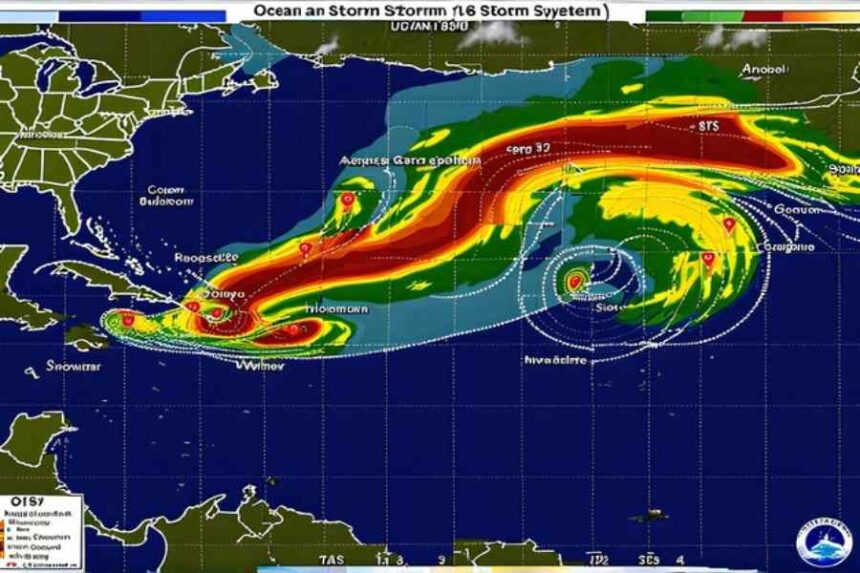The National Hurricane Center (NHC) plays a vital role in keeping communities safe by closely monitoring weather patterns in the Atlantic. Recently, the NHC has been observing a disturbance in the Atlantic with potential development, raising awareness about the unpredictable nature of tropical systems. This monitoring is crucial, especially during the Atlantic hurricane season, which typically runs from June to November. During this time, the warm ocean waters and favorable atmospheric conditions create an environment conducive to the formation of tropical depressions, storms, and hurricanes.
The disturbance currently under observation has the potential to intensify into a tropical depression or even a hurricane. Understanding how these systems develop and the factors that influence their trajectories is essential for staying prepared. The NHC employs advanced technology, including satellites, weather buoys, and predictive models, to forecast the potential impact of disturbances. These tools allow for accurate predictions, giving individuals and governments time to take necessary precautions.
How the National Hurricane Center Monitors Disturbances in the Atlantic
The National Hurricane Center (NHC) serves as the backbone of tropical weather forecasting in the Atlantic. Its primary goal is to monitor disturbances and provide timely updates to safeguard lives and property. The NHC uses state-of-the-art satellite technology to observe the development of cloud patterns, detect potential low-pressure systems, and measure sea surface temperatures. This real-time imagery allows meteorologists to assess the likelihood of disturbances intensifying into tropical storms or hurricanes. Additionally, the NHC deploys reconnaissance aircraft, often referred to as Hurricane Hunters, to collect critical data from within storms. These missions measure wind speed, air pressure, and humidity, giving forecasters valuable insights into storm dynamics. Weather buoys placed across the Atlantic also contribute to the NHC’s monitoring efforts, providing on-the-ground information about ocean and atmospheric conditions. Predictive models play a vital role in forecasting storm trajectories and potential impacts. These models analyze various environmental factors, such as wind shear and atmospheric moisture, to simulate possible storm paths. Public communication is another key component of the NHC’s efforts. The center disseminates information through advisories, forecasts, and warnings, ensuring that communities remain informed and prepared. By combining advanced technology, data analysis, and effective communication, the NHC continues to be a critical resource for tracking Atlantic weather disturbances.
Factors That Influence the Development of Atlantic Disturbances
1. Sea Surface Temperatures
Warm ocean temperatures are a critical factor in the development of tropical disturbances. When sea surface temperatures exceed 26.5°C (80°F), they provide the energy necessary for storm formation.
2. Wind Shear
Wind shear, or changes in wind speed and direction at different altitudes, can either support or hinder storm development. Low wind shear allows storms to organize and strengthen, while high wind shear disrupts their structure.
3. Atmospheric Moisture
High levels of atmospheric moisture are essential for tropical disturbances to grow. Moist air promotes the development of deep convective clouds, which are necessary for storm intensification.
4. Pre-existing Weather Systems
Features like low-pressure systems or tropical waves often serve as the seeds for tropical disturbances. These systems provide the initial conditions needed for further development.
5. Geographic Location
The Coriolis effect, caused by the Earth’s rotation, is necessary for storms to develop rotation. Disturbances closer to the equator often lack this effect, making it harder for them to organize into tropical storms or hurricanes.
6. Climate Patterns
Global climate patterns, such as El Niño and La Niña, can significantly influence Atlantic hurricane activity. El Niño tends to suppress storm formation, while La Niña creates conditions that favor development.
Steps to Stay Prepared for Atlantic Disturbances
Monitor Updates from the National Hurricane Center
Stay informed by regularly checking the NHC’s website or mobile app for updates on potential disturbances and advisories.
Prepare an Emergency Kit
Assemble a kit containing essentials like non-perishable food, water, medications, flashlights, batteries, and important documents to ensure you’re ready for any emergency.
Secure Your Property
To minimize potential storm damage, protect your home by reinforcing windows and doors, trimming trees, and securing outdoor furniture.
Develop an Evacuation Plan
Know your community’s evacuation routes and have a plan in place to leave quickly if necessary. Share the plan with your family and practice it to ensure everyone understands their roles.
Stay Connected with Local Authorities
Follow local government and emergency management agencies on social media or sign up for text alerts to receive the latest information and instructions.
Help Vulnerable Neighbors
Check-in on elderly or disabled neighbors who may need assistance in preparing for or evacuating during a storm.
Review Insurance Coverage
Ensure your homeowner’s or renter’s insurance policy covers storm-related damages, including flooding, which often requires separate coverage.
Remain Vigilant Post-Storm
After the disturbance passes, stay cautious. Avoid flooded areas, downed power lines, and unstable structures, and listen to authorities before returning to affected areas.
The Importance of Monitoring Atlantic Disturbances
- The National Hurricane Center’s efforts to monitor disturbances in the Atlantic are crucial for protecting lives, property, and communities. The Atlantic basin is highly active during hurricane season, producing tropical systems that can develop into powerful hurricanes. Monitoring these disturbances involves analyzing multiple factors, such as ocean temperatures, atmospheric conditions, and wind patterns.
- By tracking these factors, the NHC can identify potential storms early and provide forecasts for their development and movement. This early detection enables governments and local communities to prepare for potential impacts, reducing the risk of casualties and damage. Advanced satellite technology and reconnaissance aircraft play key roles in gathering real-time data, while weather buoys provide vital information about sea and atmospheric conditions.
- Additionally, predictive models allow meteorologists to simulate storm trajectories, helping determine which areas are most at risk. Beyond the science, the NHC prioritizes effective communication by issuing regular updates, warnings, and safety recommendations.
- These efforts are especially important for coastal areas, where storm surges, flooding, and high winds can have devastating impacts. As climate change continues to influence weather patterns, the NHC’s role in monitoring Atlantic disturbances remains essential for safeguarding vulnerable regions.
Key Factors Affecting the Development of Atlantic Storms
1. Warm Ocean Temperatures
The heat from warm ocean waters, particularly above 26.5°C (80°F), serves as the primary energy source for storm formation.
2. Wind Shear
Wind shear plays a dual role. Low wind shear helps storms organize and intensify, while high wind shear disrupts their structure, limiting development.
3. Atmospheric Moisture
Adequate atmospheric moisture is essential for creating the deep clouds and thunderstorms that fuel tropical systems.
4. Pre-existing Weather Disturbances
Systems like tropical waves or low-pressure areas provide the initial instability needed for a disturbance to develop further.
5. Location Relative to the Equator
Storms need the Coriolis force to develop rotation, which means disturbances closer to the equator often struggle to organize into cyclones.
6. Large-Scale Climate Patterns
Phenomena such as El Niño and La Niña significantly influence the frequency and intensity of Atlantic disturbances. For instance, El Niño tends to suppress storm activity, while La Niña creates more favorable conditions.
Conclusion
The National Hurricane Center monitoring a disturbance in the Atlantic with potential development is a crucial aspect of disaster preparedness. Their efforts ensure communities receive timely updates, allowing for proactive measures to protect lives and properties. As the Atlantic hurricane season progresses, staying informed and prepared remains essential.
FAQ’s
Q. How does the National Hurricane Center track storms?
A. The NHC monitors disturbances and forecasts their paths using satellite imagery, aircraft reconnaissance, weather buoys, and predictive models.
Q. What is the peak period of the Atlantic hurricane season?
A. The Atlantic hurricane season peaks between August and October, from June 1 to November 30.
Q. How can I stay updated on Atlantic weather disturbances?
A. Visit the NHC website, download their mobile app, or follow updates on local news outlets.
Q. Why is monitoring Atlantic disturbances important?
A. Monitoring helps communities prepare for potential impacts, reducing risks to lives, property, and the economy.
Q. What should I do during a hurricane warning?
A. Prepare your emergency kit, secure your home, stay updated on forecasts, and evacuate if instructed by authorities.




